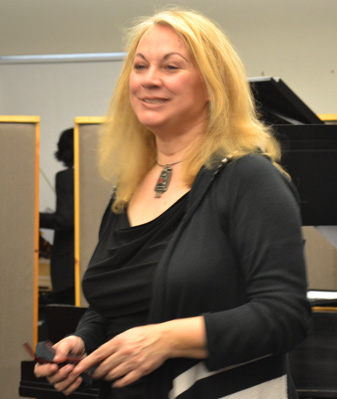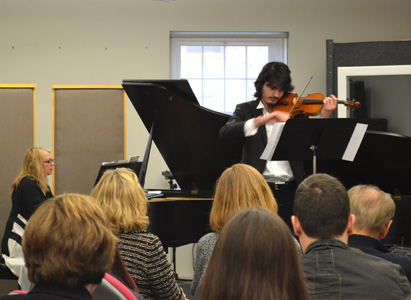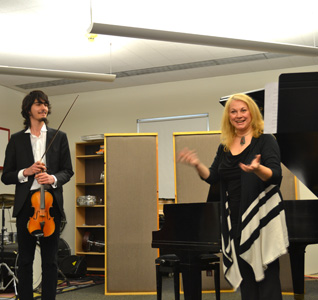Below paper was presented during
PIONEER OF THE MILLENNIUM DEVELOPMENT GOALS: ATATÜRK
Two-day International Conference at Stevens Institute of Technology in Hoboken, N.J. on April 19-20, 2013.
Organized and presented by:
The Light Millennium and College of Arts and Letters at Stevens Institute of Technology.ogy
“Ataturk: Creating a Universal language in Turkish Musical Culture”
 |
 |
| Dr. Aysegül Durakoglu, Pianist, presented “Ataturk, Creating a Universal Language in Turkish Musical Culture” paper as the concluding session of the conference. |
Dr. Aysegül Durakoglu is performing along with Yigit Karatas
for the concluding section of the Pioneer of the Millennium Development Goals: Atatürk on Saturday, April 20, 2013. |
by Dr. Aysegül DURAKOGLU, Pianist, and
Professor in Music, College of Arts and Letters at Stevens Institute of Technology.
April 20, 2013
This lecture-recital was presented by Dr. Aysegul Durakoglu as part of the International Conference on the Ataturk, Pioneer of the Millennium Development Goals on April 20, 2013, at the Stevens Institute of Technology.
Among the prominent political leaders of the 20th Century, not many articulated the significance of culture as much as the founder of the Turkish Republic, Mustafa Kemal Ataturk. Ataturk, who stated that culture was the foundation of the Turkish Republic, advanced cultural reforms in conjunction with the political, economic, legal, social and educational reforms needed to further the newly formed Turkish Republic. His principal ideal was to create a nation with a background steeped in the artistic and cultural traditions that would be developed to a high level of refinement. For Ataturk, this would only be possible by not only utilizing viable elements inherited from the ancient cultures of Anatolia as well as Pre-Islamic Turkic cultures, but by integrating those notions to modern techniques and norms, creating a uniquely Turkish identity and culture. Our modern day view of Turkey as a bridge connecting East and West can be traced back to Ataturk’s package of both political and cultural norms.
Ataturk held a unique place for artistry in his political efforts. He expressed his ideas about Arts and Music in these words:
“Sirs, all of you can be a Member of Parliament, can be a Minister, can even be a president but you cannot become artists. “
“A Nation, when deprived of art and artists, cannot have a complete life.” |
Music, in particular, holds a special place in Ataturk’s ideals to advance the Turkish culture. Ataturk was not a musician, nor an expert in music; but he was a leader with a vision who recognized the importance and relevance of Music and the Arts as well as their impact on the development and education of younger generations. He knew that music served as a unifying element at all levels of society and that it functioned as a medium for expressing individual and collective feelings and aspirations. He also thought that music existing in Turkish culture was the music of an exalted civilization, and he felt the need to bring it to higher standards by using western techniques combined with traditional elements. In a speech dated on November 1st 1934, Ataturk said:
| “Friends, I know how you want our young generation to be advanced in all kinds of fine arts. In my opinion, the Turkish music has priority and urgency in this respect. The measure for the transformation of a nation is to be perceived by the changes in its music.” |
Ataturk knew that the Turkish nation had great potential in music, and he aimed to improve it by using Western polyphonic techniques fundamentally influenced by Turkish Folk Music. He emphasized the importance of Turkish folk music many times and suggested that it must be further investigated in its roots and integrated with western styles. However, this type of transformation in Turkish musical culture, could not be made by force. It could only come through training and persuasion. Following a performance of the Presidential Orchestra established by his order, he stated that:
| “It is necessary to consider the people’s musical needs and also train them to get used to the Western music.” |
Atatürk greatly enjoyed western music. He opened a society unaccustomed to Western sounds through an instructional approach of playing it on radio stations. For that, he was strongly criticized by Turkish music experts, saying that Ataturk was trying to ban Turkish music from the radio stations. In fact, the Westernization movement had begun during the Ottomans in the first half of the 19th century and was reinforced by Sultan Abdul Aziz. Western music became more and more a part of social life in Turkey by the end of the 19th century. Italian and French Operas and operettas were performed and leading European composers and performers like Donizetti, Franz Lizst, and Henri Wieutemps were invited to perform classical music. The first school of music in the western sense, Darul-Elhan (House of Melodies), was founded. All these influences contributed to the growth of Western and later Turkish Polyphonic music.
On the other hand, it is true that the traditional Turkish music suffered during the first years of the Republic because it was banned from being played on the radio. However, it was not Ataturk who banned Turkish music; he said that the music played on the radio was not reflecting the true values of Turkish musical culture and it was banned by the Internal Affairs’ Minister. Atatürk was always fond of Turkish music especially folk songs from the Aegian region, and never criticized Turkish music; on the contrary, he said that Turkish music was of a higher civilization.
According to Turkey’s leading composer Ahmed Adnan Saygun, Ataturk became very sentimental when he heard Turkish music that moved him to tears. He invited Saygun to the presidential mansion to investigate the origin of Turkish music. Saygun told him that it goes back to the music of Central Asian Turkic cultures; pentatonism was at the source of Turkish folk music and was quite different from the Turkish classical music developed later by the Ottomans. Later in an interview, Ataturk asked a German journalist about the development of Western music in Europe. He told Ataturk that it took about four hundred years to be developed. Ataturk’s immediate reply was: “Well! We do not have that much time.”
Right after the establishment of the Turkish Republic in 1923, Ataturk did not wait at all! In such a devastating time, following the Independence War, there were 13 million people, almost no budget, no schools, hospitals, or restaurants in Turkey’s capital Ankara. Meanwhile, Ataturk was sending young musicians to abroad for musical training and planning to establish music institutions such as conservatories, orchestras, and opera houses. First, the Musiki Muallim Mektebi was reestablished as Ankara State Conservatory, then Dar-Ul-Elhan (School of Melodies) in Istanbul became the Istanbul Municipal Conservatory both providing Western classical music education. He also founded the Teacher’s College and Educational Institutions like Gazi University in 1925 to raise music educators rather than performers and composers. These were the efforts of a leader who wished to take the new nation to a different place in the world.
Now, I would like to talk about Turkish Polyphonic music to link to the performance. The first generation of Turkish composers, called “Turkish Five,” was sent to Europe by Ataturk on state scholarship to receive their music education in Europe’s finest music schools.
Upon their return to Turkey, they conducted research on the modal and rhythmic structures of Turkish folk music, and recomposed them with Western techniques. They aimed to add a polyphonic character to the monophonic structures of Turkish melodies. This is how they were able to create a universal language that was based on Turkish musical tradition. Among these composers are Ulvi Cemal Erkin, Cemal Resid Rey, Necil Kazim Akses, Ferid Alnar, and Ahmed Adnan Saygun.
Their effort was not only based on reinventing Turkish music, but also engaging fully in musical institutions and educating many students. Saygun was teaching at the Ankara Conservatory, then Istanbul Conservatory and conducting the Presidential Orchestra; Rey continuously taught at the Istanbul Municipal Conservatory and founded the Istanbul Symphony Orchestra; Erkin became the head of the Ankara Conservatory and taught many students.
Now, in today’s Turkey there had been at least three generation of composers who continuously grow in numbers and who have been internationally recognized as well.

Selected Bibliography:
• Durakoglu, Aysegul Kus, “Turkish Traditional and Polyphonic Music Through Multi-Cultural and Political Conflicts,” Contemporary Turkish Culture, Vol. 1, No. 2-2008, pp. 19-22.
• Saygun, Ahmed Adnan. Ataturk ve Musiki. Sevda-Cenap And Muzik Vakfi Yayinlari: 1. Ankara
• Tarman, Suleyman. Dogumunun 130. Yilinda Ataturk ve Muzik. Muzik Egitimi Yayinlari/26, Mayis 2011.

Dr. Aysegul Durakoglu and Yigit Karatas
Photo Credits: Cora Fernandez, The Light Millennium
- PROGRAM of the Conference's Concert Section
- FLYER of the Concert
- FULL REPORT of the Conference
- SUMMARY of the Conference
- For other PAPERS
DISCLOSURE
This PAPER may be reproduced under the following conditions only:
1. A paragraph or Introductory section could be reproduced with permission and should included full credit is as follow: “This PAPER originally presented during the PIONEER OF THE MILLENNIUM DEVELOPMENT GOALS: ATATÜRK” Two-Day International Conference on April 20, 2013, and originally e-published by The Light Millennium in the following link: http://www.lightmillennium.org/ataturk/2013/aysegul-durakoglu-paper.html
2) Please note that this Paper will be part of the planned BOOK publication.
3) Timeline of the Book Publishing: Depending on availability of sponsorship, in Fall/Winter 2013 or Spring 2014.
The conference organized and presented by: The Light Millennium and College of Arts and Letters at Stevens Institute of Technology.
http://www.lightmillennium.org - http://www.stevens.edu |